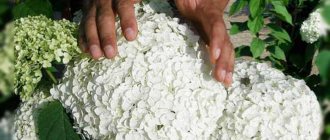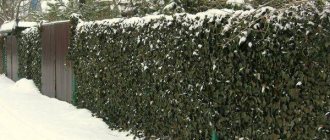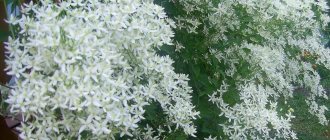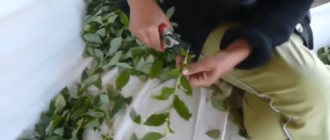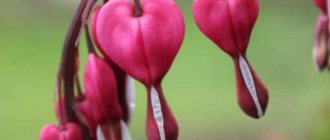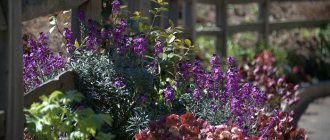If you want to make clematis a decoration for your garden, provide the flower with proper care. There is nothing complicated about it. The main rules to follow are timeliness and moderation.
If you don’t have time to remove the winter shelter from the clematis in time, the plant will begin to grow, and instead of strong shoots you will see skinny pale shoots. If you overdo it with pruning, you can forget about abundant flowering this year. If you overdo it with watering, be prepared for many problems, ranging from diseases to pests. We hope our tips will help you avoid making these mistakes.
Care for clematis that prolongs flowering!
I always looked with kind envy at the neighbor’s fence. The neighbor grew such beauty on her country plot, just a sight for sore eyes! A fence entwined with blooming clematis is a fantastically beautiful sight. It’s simply impossible to pass by indifferently.
Carl Bengtson / Flickr.com
Seeing my interest, the neighbor shared a one-year-old seedling. True, it was autumn, frost was approaching, and I did not dare to plant my acquisition in open ground. A neighbor suggested that the seedling could easily overwinter in the basement. There were, of course, doubts about this, but since there was no way out, I decided to take the advice. There were no other options anyway. Although I heard that you can just bury the seedlings on the plot, cover them, and they will overwinter well. But I didn’t take the risk and settled on the basement.
The basement, although cold, does not freeze in winter and is quite suitable for storage. I covered the roots with wet sawdust and sand. Closer to spring, I see my clematis has acquired young shoots. I had to pin it down, since the current weather did not allow planting the plant on the site.
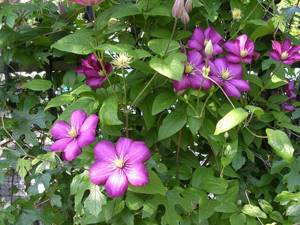
trekr/Flickr.com
By the time of planting in open ground, the seedling had germinated well.
A neighbor, a clematis fan, helped with planting and gave a complete master class on how to grow this wonderful vine.
place for planting clematis , perhaps near a fence, other fence, building or building, so as not to build additional support and at the same time protect the sprout from the wind. It is important to know that clematis prefer loose, fertile, well-fertilized soil with neutral acidity. The roots of the plant penetrate deeply into the soil, so it is advisable to avoid planting in places with close groundwater. Otherwise, they may rot.
Clematis grow in one place for 20 years, or even more, so you need to fertilize the planting hole generously, not sparing compost (a bucket and a half), ash, superphosphate or complete mineral fertilizer (100-200 g each). Then pour it well. If the soil is heavy, it won’t hurt to make a drainage layer of crushed stone, perlite or gravel.
Discuss the video
Planting clematis. The hole should be large and deep, 60-70 cm; on sandy and sandy loam soils, 50 cm is enough - both in width and depth.
When planting, the plant is buried down to the first internode, but there is no need to fill the hole completely. Leave 10 cm; over time, this space will also be filled with soil.
After planting, when the shoots grow, they are cut off. Pruning the plant in the first two years promotes the development of the root system.
Caring for clematis. Caring for clematis is not at all difficult. You need to know that they like regular and fairly abundant watering, but without stagnation of water, and stick to this. Once a week, a bucket or a half of water should be poured under the young plant. For an older plant, the watering dose is doubled. It is clear that in dry weather watering is carried out more often.
Discuss the video
If the soil is not mulched, loosening and weeding are required.
Clematis are long-flowering vines that delight with their beauty for up to 4 months. But in order for the flowering to be lush and abundant, they need to be fed four times a season . Well fertilized when planting, clematis are fed only from the second year of life. Organic fertilizers are preferable, but mineral ones won’t hurt either. Both root and foliar are welcome. In spring, it is better to feed with infusion of ash, bird droppings (1 in 30) or mullein (1 in 20). If minerals, then with a larger dose of the nitrogen component, for example, potassium nitrate. Closer to autumn, potassium-phosphorus supplements (potassium sulfate) are welcome. 25 grams is enough for a bucket of water.
My wonderful neighbor shared her secrets, the use of which is guaranteed to improve and prolong flowering.
Discuss the video
It is better to water the plant before feeding. When foliar feeding leaves, treatment is required on both sides. The best time for this work is evening hours. All feeding stops with the appearance of the first flowering shoots. The roots of clematis do not like overheating, so low-growing flowers should be planted nearby in order to create protection from the sun in this way, and to further improve the decorative appearance of the area. By using calendula for these purposes, you will also protect your flower from nematodes.
Preparing for winter. It is better to cover clematis for the winter. To avoid diseases, the soil can be treated with a solution of copper sulfate. If it rains often, to prevent the roots from rotting, the bottom of the plant is powdered with tree bark.
Discuss the video
propagate clematis by dividing the bush into parts, layering, cuttings and seeds.
This is, perhaps, all that a novice gardener should know about growing clematis.
And I can’t wait for the bright and graceful clematis to give my fence a fabulous look. After all, individual varieties produce up to several hundred flowers at a time. Can you imagine this beauty? Then plant clematis and it will be yours.
How to transplant clematis to another place?
Transplanting clematis to a new location is complicated by the fact that the plant has a fairly powerful root system, and the climbing shoots have to be cut off. Transplantation is best done in spring (late April - early May) or late summer. If spring is in no hurry to come, and the soil does not warm up until May, then “relocation” should be postponed until August.
The clematis bush needs to be dug to the depth of a spade bayonet, the plant should be removed along with a lump of earth, then the soil should be shaken off, the roots straightened and, using a sharp knife, divided into parts consisting of 4-6 stems. For each division, you should remove the roots that are not attached to the root collar and shorten those that are too long. When planting, divided clematis should be slightly deepened and covered with soil or a mound should be made around the plant.
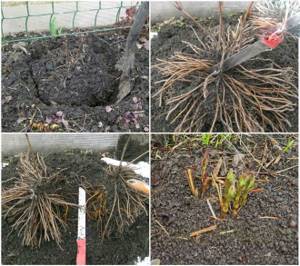
Biology of clematis
The length of the vine, stems and shoots ranges from 1 to 5 meters. Although relatively thin, these processes are quite strong. The leaves of the plant come in different shapes and shades. When clematis blooms, the sepals are considered as petals. Flowering may consist of one or several rows of 6 or 12 sepals of different shades: purple, dark blue, red, light blue, white, cream or lilac. The fruit of the plant is presented in the form of an achene, with a sprouted beak, which helps to fix the seed in the soil.

The root system of clematis includes a shortened main root and many lateral root shoots. If the growing zone is characterized by gentle climatic conditions, young shoots with adventitious roots are formed annually from the main root. The average weight of adult bushes reaches 4.5 - 5 kg, with a depth and diameter of distribution of up to 1.5 meters.
However, under the influence of certain weather and climatic factors or in the event of a lack of nutrients, the flowering of the crop may be impaired. Therefore, the gardener should figure out why clematis does not bloom, but only produces foliage, in order to take care of the plant in time and ensure high-quality flowering.

Photo of clematis
In conclusion - photos of different varieties of clematis. These are not my plants, I just photographed this miracle everywhere I saw it.
Variety Ballerina Clematis Shin-Shigoku

Clematis Solidarity Clematis Red Gramophone
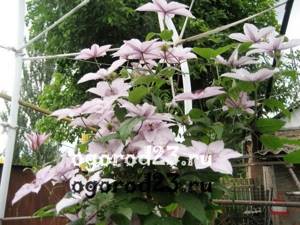
How does clematis propagate?
Lianas are propagated by dividing the bush, layering, cuttings, and seeds (but this is quite difficult). The easiest way is by dividing the bush or layering.
The perennial bush is dug up and carefully divided (cut) so that each section has one or two buds. The roots can be dipped in a solution of potassium permanganate or powdered with crushed coal. You can hold it for some time (while a new place is being prepared) in a solution of root or heteroauxin.
Propagation by layering of clematis is also simple. A ditch is dug from the bush left to right or in a circle around the bush, into which humus, sand or compost is added. One lash is placed in the groove, covered completely with earth, but the top of the clematis lash should be on top of the ground. Then the groove, or rather the place where the cuttings lie, is watered and mulched.
After two years, clematis layerings can be dug up, starting from the free-lying top. By this time, the roots are developing well and are suitable for replanting.

